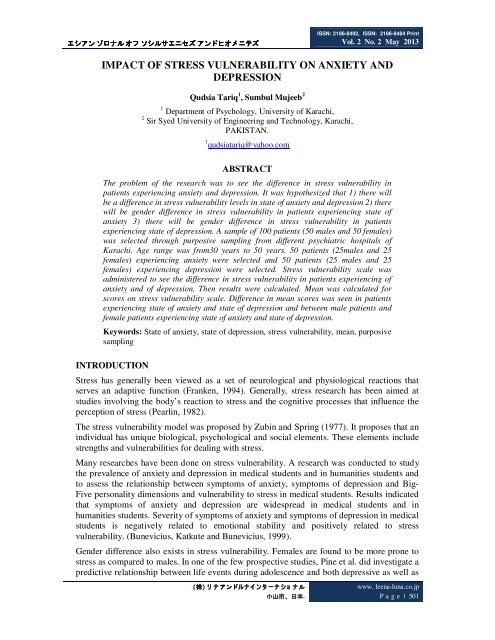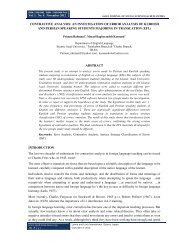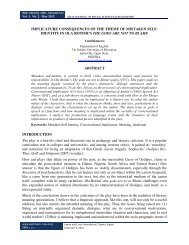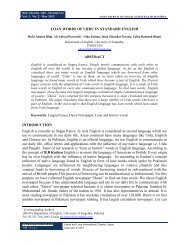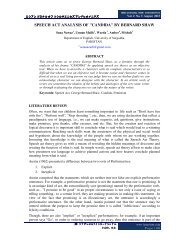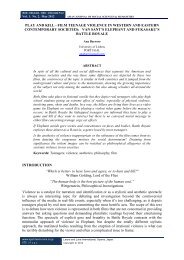impact of stress vulnerability on anxiety and depression
impact of stress vulnerability on anxiety and depression
impact of stress vulnerability on anxiety and depression
You also want an ePaper? Increase the reach of your titles
YUMPU automatically turns print PDFs into web optimized ePapers that Google loves.
エシアン ゾロナル オフ ソシルサエニセズ アンドヒオメニテズISSN: 2186-8492, ISSN: 2186-8484 PrintVol. 2 No. 2 May 2013IMPACT OF STRESS VULNERABILITY ON ANXIETY ANDDEPRESSIONQudsia Tariq 1 , Sumbul Mujeeb 21 Department <str<strong>on</strong>g>of</str<strong>on</strong>g> Psychology, University <str<strong>on</strong>g>of</str<strong>on</strong>g> Karachi,2 Sir Syed University <str<strong>on</strong>g>of</str<strong>on</strong>g> Engineering <strong>and</strong> Technology, Karachi,PAKISTAN.1 qudsiatariq@yahoo.comABSTRACTThe problem <str<strong>on</strong>g>of</str<strong>on</strong>g> the research was to see the difference in <str<strong>on</strong>g>stress</str<strong>on</strong>g> <str<strong>on</strong>g>vulnerability</str<strong>on</strong>g> inpatients experiencing <strong>anxiety</strong> <strong>and</strong> depressi<strong>on</strong>. It was hypothesized that 1) there willbe a difference in <str<strong>on</strong>g>stress</str<strong>on</strong>g> <str<strong>on</strong>g>vulnerability</str<strong>on</strong>g> levels in state <str<strong>on</strong>g>of</str<strong>on</strong>g> <strong>anxiety</strong> <strong>and</strong> depressi<strong>on</strong> 2) therewill be gender difference in <str<strong>on</strong>g>stress</str<strong>on</strong>g> <str<strong>on</strong>g>vulnerability</str<strong>on</strong>g> in patients experiencing state <str<strong>on</strong>g>of</str<strong>on</strong>g><strong>anxiety</strong> 3) there will be gender difference in <str<strong>on</strong>g>stress</str<strong>on</strong>g> <str<strong>on</strong>g>vulnerability</str<strong>on</strong>g> in patientsexperiencing state <str<strong>on</strong>g>of</str<strong>on</strong>g> depressi<strong>on</strong>. A sample <str<strong>on</strong>g>of</str<strong>on</strong>g> 100 patients (50 males <strong>and</strong> 50 females)was selected through purposive sampling from different psychiatric hospitals <str<strong>on</strong>g>of</str<strong>on</strong>g>Karachi. Age range was from30 years to 50 years. 50 patients (25males <strong>and</strong> 25females) experiencing <strong>anxiety</strong> were selected <strong>and</strong> 50 patients (25 males <strong>and</strong> 25females) experiencing depressi<strong>on</strong> were selected. Stress <str<strong>on</strong>g>vulnerability</str<strong>on</strong>g> scale wasadministered to see the difference in <str<strong>on</strong>g>stress</str<strong>on</strong>g> <str<strong>on</strong>g>vulnerability</str<strong>on</strong>g> in patients experiencing <str<strong>on</strong>g>of</str<strong>on</strong>g><strong>anxiety</strong> <strong>and</strong> <str<strong>on</strong>g>of</str<strong>on</strong>g> depressi<strong>on</strong>. Then results were calculated. Mean was calculated forscores <strong>on</strong> <str<strong>on</strong>g>stress</str<strong>on</strong>g> <str<strong>on</strong>g>vulnerability</str<strong>on</strong>g> scale. Difference in mean scores was seen in patientsexperiencing state <str<strong>on</strong>g>of</str<strong>on</strong>g> <strong>anxiety</strong> <strong>and</strong> state <str<strong>on</strong>g>of</str<strong>on</strong>g> depressi<strong>on</strong> <strong>and</strong> between male patients <strong>and</strong>female patients experiencing state <str<strong>on</strong>g>of</str<strong>on</strong>g> <strong>anxiety</strong> <strong>and</strong> state <str<strong>on</strong>g>of</str<strong>on</strong>g> depressi<strong>on</strong>.Keywords: State <str<strong>on</strong>g>of</str<strong>on</strong>g> <strong>anxiety</strong>, state <str<strong>on</strong>g>of</str<strong>on</strong>g> depressi<strong>on</strong>, <str<strong>on</strong>g>stress</str<strong>on</strong>g> <str<strong>on</strong>g>vulnerability</str<strong>on</strong>g>, mean, purposivesamplingINTRODUCTIONStress has generally been viewed as a set <str<strong>on</strong>g>of</str<strong>on</strong>g> neurological <strong>and</strong> physiological reacti<strong>on</strong>s thatserves an adaptive functi<strong>on</strong> (Franken, 1994). Generally, <str<strong>on</strong>g>stress</str<strong>on</strong>g> research has been aimed atstudies involving the body’s reacti<strong>on</strong> to <str<strong>on</strong>g>stress</str<strong>on</strong>g> <strong>and</strong> the cognitive processes that influence thepercepti<strong>on</strong> <str<strong>on</strong>g>of</str<strong>on</strong>g> <str<strong>on</strong>g>stress</str<strong>on</strong>g> (Pearlin, 1982).The <str<strong>on</strong>g>stress</str<strong>on</strong>g> <str<strong>on</strong>g>vulnerability</str<strong>on</strong>g> model was proposed by Zubin <strong>and</strong> Spring (1977). It proposes that anindividual has unique biological, psychological <strong>and</strong> social elements. These elements includestrengths <strong>and</strong> vulnerabilities for dealing with <str<strong>on</strong>g>stress</str<strong>on</strong>g>.Many researches have been d<strong>on</strong>e <strong>on</strong> <str<strong>on</strong>g>stress</str<strong>on</strong>g> <str<strong>on</strong>g>vulnerability</str<strong>on</strong>g>. A research was c<strong>on</strong>ducted to studythe prevalence <str<strong>on</strong>g>of</str<strong>on</strong>g> <strong>anxiety</strong> <strong>and</strong> depressi<strong>on</strong> in medical students <strong>and</strong> in humanities students <strong>and</strong>to assess the relati<strong>on</strong>ship between symptoms <str<strong>on</strong>g>of</str<strong>on</strong>g> <strong>anxiety</strong>, symptoms <str<strong>on</strong>g>of</str<strong>on</strong>g> depressi<strong>on</strong> <strong>and</strong> Big-Five pers<strong>on</strong>ality dimensi<strong>on</strong>s <strong>and</strong> <str<strong>on</strong>g>vulnerability</str<strong>on</strong>g> to <str<strong>on</strong>g>stress</str<strong>on</strong>g> in medical students. Results indicatedthat symptoms <str<strong>on</strong>g>of</str<strong>on</strong>g> <strong>anxiety</strong> <strong>and</strong> depressi<strong>on</strong> are widespread in medical students <strong>and</strong> inhumanities students. Severity <str<strong>on</strong>g>of</str<strong>on</strong>g> symptoms <str<strong>on</strong>g>of</str<strong>on</strong>g> <strong>anxiety</strong> <strong>and</strong> symptoms <str<strong>on</strong>g>of</str<strong>on</strong>g> depressi<strong>on</strong> in medicalstudents is negatively related to emoti<strong>on</strong>al stability <strong>and</strong> positively related to <str<strong>on</strong>g>stress</str<strong>on</strong>g><str<strong>on</strong>g>vulnerability</str<strong>on</strong>g>. (Bunevicius, Katkute <strong>and</strong> Bunevicius, 1999).Gender difference also exists in <str<strong>on</strong>g>stress</str<strong>on</strong>g> <str<strong>on</strong>g>vulnerability</str<strong>on</strong>g>. Females are found to be more pr<strong>on</strong>e to<str<strong>on</strong>g>stress</str<strong>on</strong>g> as compared to males. In <strong>on</strong>e <str<strong>on</strong>g>of</str<strong>on</strong>g> the few prospective studies, Pine et al. did investigate apredictive relati<strong>on</strong>ship between life events during adolescence <strong>and</strong> both depressive as well as( 株 ) リ リアンドル リ ル ル ル ル リ ル ル リ ル小 山 市 、 日 本 .www. leena-luna.co.jpP a g e | 501
ISSN: 2186-8492, ISSN: 2186-8484 PrintVol. 2 No. 2 May 2013ASIAN JOURNAL OF SOCIAL SCIENCES & HUMANITIESgeneralized <strong>anxiety</strong> disorder symptoms. Interestingly, the associati<strong>on</strong> with <strong>anxiety</strong> waslimited to females, c<strong>on</strong>sistent with differential <str<strong>on</strong>g>vulnerability</str<strong>on</strong>g> to <str<strong>on</strong>g>stress</str<strong>on</strong>g> across genders.Another research discovered gender differences for <strong>anxiety</strong>, depressi<strong>on</strong> <strong>and</strong> <str<strong>on</strong>g>stress</str<strong>on</strong>g> am<strong>on</strong>gsurvivors <str<strong>on</strong>g>of</str<strong>on</strong>g> suicide bombings in Lahore, Pakistan. The results point to c<strong>on</strong>siderable genderdifferences in depressi<strong>on</strong>, <strong>anxiety</strong> <strong>and</strong> <str<strong>on</strong>g>stress</str<strong>on</strong>g> reported by the survivors <str<strong>on</strong>g>of</str<strong>on</strong>g> suicide bombings.The result further showed that female survivors scored higher <strong>on</strong> depressi<strong>on</strong>, <strong>anxiety</strong> <strong>and</strong><str<strong>on</strong>g>stress</str<strong>on</strong>g> than their male counterpart. Moreover, positive significant relati<strong>on</strong>ship was foundbetween <str<strong>on</strong>g>stress</str<strong>on</strong>g> <strong>and</strong> depressi<strong>on</strong>, <str<strong>on</strong>g>stress</str<strong>on</strong>g> <strong>and</strong> <strong>anxiety</strong>, depressi<strong>on</strong> <strong>and</strong> <strong>anxiety</strong> (Farooqi & Habib,2010).In the light <str<strong>on</strong>g>of</str<strong>on</strong>g> previous researches the objective <str<strong>on</strong>g>of</str<strong>on</strong>g> this study was to see the difference in<str<strong>on</strong>g>stress</str<strong>on</strong>g> <str<strong>on</strong>g>vulnerability</str<strong>on</strong>g> in patients experiencing state <str<strong>on</strong>g>of</str<strong>on</strong>g> <strong>anxiety</strong> <strong>and</strong> state <str<strong>on</strong>g>of</str<strong>on</strong>g> depressi<strong>on</strong>. It washypothesized that 1) there will be a difference in <str<strong>on</strong>g>stress</str<strong>on</strong>g> <str<strong>on</strong>g>vulnerability</str<strong>on</strong>g> levels in state <str<strong>on</strong>g>of</str<strong>on</strong>g> <strong>anxiety</strong><strong>and</strong> state <str<strong>on</strong>g>of</str<strong>on</strong>g> depressi<strong>on</strong> 2) There will be gender difference in <str<strong>on</strong>g>stress</str<strong>on</strong>g> <str<strong>on</strong>g>vulnerability</str<strong>on</strong>g> in patientsexperiencing state <str<strong>on</strong>g>of</str<strong>on</strong>g> <strong>anxiety</strong> 3) There will be gender difference in <str<strong>on</strong>g>stress</str<strong>on</strong>g> <str<strong>on</strong>g>vulnerability</str<strong>on</strong>g> inpatients experiencing state <str<strong>on</strong>g>of</str<strong>on</strong>g> depressi<strong>on</strong>. The c<strong>on</strong>trols were age, gender, material, targetpopulati<strong>on</strong> <strong>and</strong> hospital setting.METHODOLOGYThis secti<strong>on</strong> includes sample, target populati<strong>on</strong>, materials, ethical c<strong>on</strong>siderati<strong>on</strong>, statisticalanalysis <strong>and</strong> procedures.SampleA Sample <str<strong>on</strong>g>of</str<strong>on</strong>g> 100 patients suffering from depressi<strong>on</strong> <strong>and</strong> <strong>anxiety</strong> disorder were selectedthrough purposive sampling from different hospitals <str<strong>on</strong>g>of</str<strong>on</strong>g> Karachi including both private <strong>and</strong>government hospitals. The sample included 50 male patients <strong>and</strong> 50 female patients. Theirage ranged from 30 years to 50 years. The selecti<strong>on</strong> criteri<strong>on</strong>s was based <strong>on</strong> the fact that thepatient should have some knowledge <str<strong>on</strong>g>of</str<strong>on</strong>g> English language so that they could bettercomprehend the items <strong>on</strong> the scales being used The sec<strong>on</strong>d criteri<strong>on</strong> for selecti<strong>on</strong> was thatshould have <strong>on</strong>ly been diagnostically labeled as either depressi<strong>on</strong>s patients or <strong>anxiety</strong> patients<strong>and</strong> not diagnosed for any other disorder al<strong>on</strong>g with it.MaterialA Demographic sheetwas designed to gather the informati<strong>on</strong> <str<strong>on</strong>g>of</str<strong>on</strong>g> the participants which Included name, age, gender,qualificati<strong>on</strong>, marital status, occupati<strong>on</strong> <strong>and</strong> the labeled disorder.Stress <str<strong>on</strong>g>vulnerability</str<strong>on</strong>g> scalea subscale <str<strong>on</strong>g>of</str<strong>on</strong>g> Stress Audit Questi<strong>on</strong>naire. (Miller <strong>and</strong> Smith, 1983, 1988) was used. StressVulnerability Scale (SVS) is used to test measures the individual’s <str<strong>on</strong>g>vulnerability</str<strong>on</strong>g> to <str<strong>on</strong>g>stress</str<strong>on</strong>g> thathow much a pers<strong>on</strong> is pr<strong>on</strong>e to physical <strong>and</strong> psychological <str<strong>on</strong>g>stress</str<strong>on</strong>g>. It c<strong>on</strong>tains 20 itemsarranged in a 5 point Likert type scale. It entails degrees ranging from 1 (always) to 5 (never)respectively <strong>and</strong> the subject had to rate each item according to how much <str<strong>on</strong>g>of</str<strong>on</strong>g> the time thestatement was true <str<strong>on</strong>g>of</str<strong>on</strong>g> him/ her. To get the final score, the score was added up <strong>and</strong> 20 weresubtracted from the actual score. A score below 10 indicates excellent resistance to <str<strong>on</strong>g>stress</str<strong>on</strong>g>. Ascore over 30 indicates some <str<strong>on</strong>g>vulnerability</str<strong>on</strong>g> to <str<strong>on</strong>g>stress</str<strong>on</strong>g>; <strong>and</strong> subject is seriously vulnerable if his/her score is above 50.www.ajssh.leena-luna.co.jp502 | P a g eLeena <strong>and</strong> Luna Internati<strong>on</strong>al, Oyama, Japan.Copyright © 2013
エシアン ゾロナル オフ ソシルサエニセズ アンドヒオメニテズISSN: 2186-8492, ISSN: 2186-8484 PrintVol. 2 No. 2 May 2013Experimental DesignIn this study the Survey co relati<strong>on</strong>al research design was used to explore how Stress canmake patients vulnerable towards certain disorders. This method was preferred because it isless time c<strong>on</strong>suming <strong>and</strong> efficient.ProcedureThe study was c<strong>on</strong>ducted at different hospitals <str<strong>on</strong>g>of</str<strong>on</strong>g> Karachi. The initial step was to get thec<strong>on</strong>sent forms read <strong>and</strong> signed by the participants. The participants were clearlycommunicated their rights to withdraw from the study any time they desired. Then theirverbal c<strong>on</strong>sent was taken, after taking their agreement <strong>and</strong> providing them with necessaryinformati<strong>on</strong>, the patients filled in the demographic sheet which comprised <str<strong>on</strong>g>of</str<strong>on</strong>g> their pers<strong>on</strong>alinformati<strong>on</strong> .After completing the ethical formalities the participants were presented with thescale that measured <str<strong>on</strong>g>vulnerability</str<strong>on</strong>g> towards <str<strong>on</strong>g>stress</str<strong>on</strong>g> It was explained to Resp<strong>on</strong>ses were noteddown <strong>and</strong> later the results were then calculated.Ethical C<strong>on</strong>siderati<strong>on</strong>sVerbal c<strong>on</strong>sent <str<strong>on</strong>g>of</str<strong>on</strong>g> participants was taken before c<strong>on</strong>ducting the research study. Theparticipants <str<strong>on</strong>g>of</str<strong>on</strong>g> the study were told about their right to withdraw from study any time they feltany kind <str<strong>on</strong>g>of</str<strong>on</strong>g> threat <strong>and</strong> they were reassured <str<strong>on</strong>g>of</str<strong>on</strong>g> c<strong>on</strong>fidentiality related to their pers<strong>on</strong>alinformati<strong>on</strong>.Statistical AnalysisMean was calculated for scores <strong>on</strong> <str<strong>on</strong>g>stress</str<strong>on</strong>g> <str<strong>on</strong>g>vulnerability</str<strong>on</strong>g> scale. Difference in mean scores wasseen in patients experiencing state <str<strong>on</strong>g>of</str<strong>on</strong>g> <strong>anxiety</strong> <strong>and</strong> state <str<strong>on</strong>g>of</str<strong>on</strong>g> depressi<strong>on</strong> <strong>and</strong> between malepatients <strong>and</strong> female patients experiencing state <str<strong>on</strong>g>of</str<strong>on</strong>g> <strong>anxiety</strong> <strong>and</strong> state <str<strong>on</strong>g>of</str<strong>on</strong>g> depressi<strong>on</strong>.RESULTSThis secti<strong>on</strong> included the descriptive statistics, graphs <strong>and</strong> tables. Refer to the tables <strong>and</strong>graphs below for results.Table 1. Table showing mean values for scores <strong>on</strong> <str<strong>on</strong>g>stress</str<strong>on</strong>g> <str<strong>on</strong>g>vulnerability</str<strong>on</strong>g> scale in patientsexperiencing state <str<strong>on</strong>g>of</str<strong>on</strong>g> <strong>anxiety</strong> <strong>and</strong> state <str<strong>on</strong>g>of</str<strong>on</strong>g> depressi<strong>on</strong>Male Female BothDepressi<strong>on</strong> 36.33 32.166 34.25Anxiety 37.166 37.166 37.166Note: Table 1 showing mean values for patients experiencing state <str<strong>on</strong>g>of</str<strong>on</strong>g> depressi<strong>on</strong> is 34.25 <strong>and</strong>means values for patients experiencing state <str<strong>on</strong>g>of</str<strong>on</strong>g> <strong>anxiety</strong> is 37.166.383634Depressi<strong>on</strong>Anxiety32Graph 1. Showing mean values for <str<strong>on</strong>g>stress</str<strong>on</strong>g> <str<strong>on</strong>g>vulnerability</str<strong>on</strong>g> in patients experiencing state <str<strong>on</strong>g>of</str<strong>on</strong>g> <strong>anxiety</strong> <strong>and</strong>state <str<strong>on</strong>g>of</str<strong>on</strong>g> depressi<strong>on</strong>( 株 ) リ リアンドル リ ル ル ル ル リ ル ル リ ル小 山 市 、 日 本 .www. leena-luna.co.jpP a g e | 503
ISSN: 2186-8492, ISSN: 2186-8484 PrintVol. 2 No. 2 May 2013ASIAN JOURNAL OF SOCIAL SCIENCES & HUMANITIESNote: as shown in graph 1, mean values for patients experiencing state <str<strong>on</strong>g>of</str<strong>on</strong>g> depressi<strong>on</strong> is 34.25<strong>and</strong> means values for patients experiencing state <str<strong>on</strong>g>of</str<strong>on</strong>g> <strong>anxiety</strong> is 37.1663736353433323130MalesFemalesGraph 2. Showing gender difference in <str<strong>on</strong>g>stress</str<strong>on</strong>g> <str<strong>on</strong>g>vulnerability</str<strong>on</strong>g> in patients experiencing state <str<strong>on</strong>g>of</str<strong>on</strong>g> depressi<strong>on</strong>Note: As shown in graph 2 mean value for male patients experiencing state <str<strong>on</strong>g>of</str<strong>on</strong>g> depressi<strong>on</strong> is36.33 <strong>and</strong> means value for female patients experiencing state <str<strong>on</strong>g>of</str<strong>on</strong>g> depressi<strong>on</strong> is 32.166 hencethere is significant difference found40302010MalesFemales0Graph 3. Showing gender difference in <str<strong>on</strong>g>stress</str<strong>on</strong>g> <str<strong>on</strong>g>vulnerability</str<strong>on</strong>g> in patients experiencing state <str<strong>on</strong>g>of</str<strong>on</strong>g> <strong>anxiety</strong>Note: As shown in graph 3 mean value for male patients experiencing state <str<strong>on</strong>g>of</str<strong>on</strong>g> <strong>anxiety</strong> is37.166 <strong>and</strong> means value for female patients experiencing state <str<strong>on</strong>g>of</str<strong>on</strong>g> <strong>anxiety</strong> is 37.166 hence nodifference is foundDISCUSSIONThe first hypothesis was there will be a difference in <str<strong>on</strong>g>stress</str<strong>on</strong>g> <str<strong>on</strong>g>vulnerability</str<strong>on</strong>g> levels in state <str<strong>on</strong>g>of</str<strong>on</strong>g><strong>anxiety</strong> <strong>and</strong> depressi<strong>on</strong>. According to the results difference is found between <str<strong>on</strong>g>stress</str<strong>on</strong>g><str<strong>on</strong>g>vulnerability</str<strong>on</strong>g> level in state <str<strong>on</strong>g>of</str<strong>on</strong>g> <strong>anxiety</strong> <strong>and</strong> depressi<strong>on</strong>. There might be several reas<strong>on</strong>s for thisdifference in <str<strong>on</strong>g>stress</str<strong>on</strong>g> <str<strong>on</strong>g>vulnerability</str<strong>on</strong>g> level in state <str<strong>on</strong>g>of</str<strong>on</strong>g> <strong>anxiety</strong> <strong>and</strong> depressi<strong>on</strong>.One reas<strong>on</strong> for this difference might be the role <str<strong>on</strong>g>of</str<strong>on</strong>g> pers<strong>on</strong>ality characteristics. The role <str<strong>on</strong>g>of</str<strong>on</strong>g><str<strong>on</strong>g>stress</str<strong>on</strong>g> <str<strong>on</strong>g>vulnerability</str<strong>on</strong>g> factors in the l<strong>on</strong>g-term course <str<strong>on</strong>g>of</str<strong>on</strong>g> <strong>anxiety</strong> <strong>and</strong> depressed moodSpecifically, the role <str<strong>on</strong>g>of</str<strong>on</strong>g> pers<strong>on</strong>ality characteristics (neuroticism, extraversi<strong>on</strong>), physical <strong>and</strong>psychological <str<strong>on</strong>g>stress</str<strong>on</strong>g>ors (clinical status, disease influence <strong>on</strong> daily life, major life events), <strong>and</strong>coping <strong>and</strong> social support at the time <str<strong>on</strong>g>of</str<strong>on</strong>g> diagnosis predict changes in <strong>anxiety</strong> <strong>and</strong> depressedmood 3 <strong>and</strong> 5 years later. (Evers, Kraaimaat, Geenen, Jacobs <strong>and</strong> Bijlsma, 2002)Other reas<strong>on</strong> could be the perceived level <str<strong>on</strong>g>of</str<strong>on</strong>g> <str<strong>on</strong>g>stress</str<strong>on</strong>g> experienced during the state <str<strong>on</strong>g>of</str<strong>on</strong>g> <strong>anxiety</strong><strong>and</strong> state <str<strong>on</strong>g>of</str<strong>on</strong>g> depressi<strong>on</strong>. Al<strong>on</strong>g with the perceived <str<strong>on</strong>g>stress</str<strong>on</strong>g> the gender <strong>and</strong> age differences alsoplay a significant role in determining the <str<strong>on</strong>g>stress</str<strong>on</strong>g> level. According to Bergdah, 2002 women inthe 30 to 39-year age group are exposed to high <str<strong>on</strong>g>stress</str<strong>on</strong>g> <strong>and</strong> are therefore a vulnerable group.Another reas<strong>on</strong> could be due to the differences in AMPA receptor functi<strong>on</strong> may be linked toindividual variati<strong>on</strong>s in <str<strong>on</strong>g>stress</str<strong>on</strong>g> <str<strong>on</strong>g>vulnerability</str<strong>on</strong>g>. Duels to differences in APMA receptors, somewww.ajssh.leena-luna.co.jp504 | P a g eLeena <strong>and</strong> Luna Internati<strong>on</strong>al, Oyama, Japan.Copyright © 2013
エシアン ゾロナル オフ ソシルサエニセズ アンドヒオメニテズISSN: 2186-8492, ISSN: 2186-8484 PrintVol. 2 No. 2 May 2013individuals are more pr<strong>on</strong>e to <str<strong>on</strong>g>stress</str<strong>on</strong>g> while others are less pr<strong>on</strong>e to <str<strong>on</strong>g>stress</str<strong>on</strong>g>. Increased<str<strong>on</strong>g>vulnerability</str<strong>on</strong>g> aversive experiences are <strong>on</strong>e <str<strong>on</strong>g>of</str<strong>on</strong>g> the main risk factors for <str<strong>on</strong>g>stress</str<strong>on</strong>g>-relatedpsychiatric disorders as major depressi<strong>on</strong>. However, the molecular bases <str<strong>on</strong>g>of</str<strong>on</strong>g> <str<strong>on</strong>g>vulnerability</str<strong>on</strong>g>, <strong>and</strong><str<strong>on</strong>g>stress</str<strong>on</strong>g> resilience are still not understood. Increasing clinical <strong>and</strong> preclinical evidence suggestsa central involvement <str<strong>on</strong>g>of</str<strong>on</strong>g> the glutamatergic system in the pathogenesis <str<strong>on</strong>g>of</str<strong>on</strong>g> major depressi<strong>on</strong>.(Schmidt, M. V. et al, 2010)Individual’s reactivity to <str<strong>on</strong>g>stress</str<strong>on</strong>g> also determines <str<strong>on</strong>g>vulnerability</str<strong>on</strong>g> to <str<strong>on</strong>g>stress</str<strong>on</strong>g> in different c<strong>on</strong>diti<strong>on</strong>s.Reactivity is the likelihood that an individual will react emoti<strong>on</strong>ally or physically to daily<str<strong>on</strong>g>stress</str<strong>on</strong>g>ors <strong>and</strong> depends <strong>on</strong> the individual’s resilience or <str<strong>on</strong>g>vulnerability</str<strong>on</strong>g> (Bolger & Zuckerman,1995). The <str<strong>on</strong>g>stress</str<strong>on</strong>g>or-reactivity path illustrates that socio demographic, psychosocial, <strong>and</strong>health factors modify how daily <str<strong>on</strong>g>stress</str<strong>on</strong>g>ors affect daily well-being. Individual’s pers<strong>on</strong>alresources (e.g., their educati<strong>on</strong>, income, feelings <str<strong>on</strong>g>of</str<strong>on</strong>g> mastery <strong>and</strong> c<strong>on</strong>trol over theirenvir<strong>on</strong>ment, <strong>and</strong> physical health) <strong>and</strong> envir<strong>on</strong>mental resources (e.g., social support) affecthow they can cope with daily experiences (Lazarus, 1999).The socio demographic features like educati<strong>on</strong> that also plays a role in how an individualcope with <str<strong>on</strong>g>stress</str<strong>on</strong>g>ful situati<strong>on</strong>s. C<strong>on</strong>sistent with research <strong>on</strong> socio ec<strong>on</strong>omic inequalities inhealth, study indicated that better educated adults reported fewer physical symptoms <strong>and</strong> lesspsychological di<str<strong>on</strong>g>stress</str<strong>on</strong>g> than less-educated adults (Grzywac, Almeida, Neupert, & Ettner,2004). In c<strong>on</strong>trast to studies <str<strong>on</strong>g>of</str<strong>on</strong>g> life-event <str<strong>on</strong>g>stress</str<strong>on</strong>g>ors, this study found that college-educatedindividuals reported more daily <str<strong>on</strong>g>stress</str<strong>on</strong>g>ors than those with no more that high-school educated.However, college educated resp<strong>on</strong>dents were less reactive to <str<strong>on</strong>g>stress</str<strong>on</strong>g>ors, which indicate thatsocio-ec<strong>on</strong>omic differentials in daily health could be attributed to differential reactivity to<str<strong>on</strong>g>stress</str<strong>on</strong>g>ors rather than to differential exposure to <str<strong>on</strong>g>stress</str<strong>on</strong>g>ors. Participants who experiencedchr<strong>on</strong>ic <str<strong>on</strong>g>stress</str<strong>on</strong>g>ors were more likely than those who did not to report psychological di<str<strong>on</strong>g>stress</str<strong>on</strong>g> <strong>on</strong>days when they experienced daily <str<strong>on</strong>g>stress</str<strong>on</strong>g>ors (Serido, Almeida, & Wethingt<strong>on</strong>, 2004). Forwomen, the interacti<strong>on</strong> <str<strong>on</strong>g>of</str<strong>on</strong>g> home hassles <strong>and</strong> chr<strong>on</strong>ic <str<strong>on</strong>g>stress</str<strong>on</strong>g>ors was significant; for men, it wasthe interacti<strong>on</strong> <str<strong>on</strong>g>of</str<strong>on</strong>g> work hassles <strong>and</strong> chr<strong>on</strong>ic <str<strong>on</strong>g>stress</str<strong>on</strong>g>ors that was significant.The difference found between <str<strong>on</strong>g>stress</str<strong>on</strong>g> <str<strong>on</strong>g>vulnerability</str<strong>on</strong>g> level in state <str<strong>on</strong>g>of</str<strong>on</strong>g> <strong>anxiety</strong> <strong>and</strong> depressi<strong>on</strong>could be due to etiological factors. Anxiety <strong>and</strong> depressi<strong>on</strong> are related to each other at thelevel <str<strong>on</strong>g>of</str<strong>on</strong>g> symptoms <strong>and</strong> disorder. A study tested the etiological factors from two cognitive<str<strong>on</strong>g>vulnerability</str<strong>on</strong>g>-<str<strong>on</strong>g>stress</str<strong>on</strong>g> models <str<strong>on</strong>g>of</str<strong>on</strong>g> depressi<strong>on</strong> (Hopelessness theory <strong>and</strong> Beck’s Theory). TheComparis<strong>on</strong> <str<strong>on</strong>g>of</str<strong>on</strong>g> the two theories implies that their cognitive <str<strong>on</strong>g>vulnerability</str<strong>on</strong>g>-<str<strong>on</strong>g>stress</str<strong>on</strong>g> comp<strong>on</strong>entsoverlap largely in the predicti<strong>on</strong> <str<strong>on</strong>g>of</str<strong>on</strong>g> depressi<strong>on</strong>. (Hankin, Abrams<strong>on</strong>, Haeffe <strong>and</strong> Miller, 2004)Different people adopt different coping strategies to deal with <str<strong>on</strong>g>stress</str<strong>on</strong>g> so people experiencingstate <str<strong>on</strong>g>of</str<strong>on</strong>g> <strong>anxiety</strong> <strong>and</strong> state <str<strong>on</strong>g>of</str<strong>on</strong>g> depressi<strong>on</strong> use different ways <str<strong>on</strong>g>of</str<strong>on</strong>g> coping with <str<strong>on</strong>g>stress</str<strong>on</strong>g>. Somemethods <str<strong>on</strong>g>of</str<strong>on</strong>g> coping with life’s difficulties seem to be more effective than others. People whouse effective coping skills seem to deal with <str<strong>on</strong>g>stress</str<strong>on</strong>g> better than those who do not. They canh<strong>and</strong>le much more <str<strong>on</strong>g>stress</str<strong>on</strong>g> before they develop symptoms <str<strong>on</strong>g>of</str<strong>on</strong>g> mental disorder. (Warner R.1994)Another reas<strong>on</strong> might be that different people have diverse ways <str<strong>on</strong>g>of</str<strong>on</strong>g> thinking aboutthemselves <strong>and</strong> world around them so people experiencing state <str<strong>on</strong>g>of</str<strong>on</strong>g> <strong>anxiety</strong> <strong>and</strong> state <str<strong>on</strong>g>of</str<strong>on</strong>g>depressi<strong>on</strong> have different ways <str<strong>on</strong>g>of</str<strong>on</strong>g> thinking about themselves <strong>and</strong> world around them, whichcould have affected their <str<strong>on</strong>g>vulnerability</str<strong>on</strong>g> to <str<strong>on</strong>g>stress</str<strong>on</strong>g>. This is more than simple being optimistic orpessimistic-there are certain thinking methods which help people to cope better thanothers(Thomas P. 1997) (Warner R. 2000)Individual differences play a major role in <str<strong>on</strong>g>stress</str<strong>on</strong>g> <str<strong>on</strong>g>vulnerability</str<strong>on</strong>g>. Stress is not caused by a singlefactor it can be used by different other factors. Some <str<strong>on</strong>g>stress</str<strong>on</strong>g>ors are unhealthier than other( 株 ) リ リアンドル リ ル ル ル ル リ ル ル リ ル小 山 市 、 日 本 .www. leena-luna.co.jpP a g e | 505
ISSN: 2186-8492, ISSN: 2186-8484 PrintVol. 2 No. 2 May 2013ASIAN JOURNAL OF SOCIAL SCIENCES & HUMANITIESAnnual Meeting October 1996 vol. 40 no. 12 579-583. doi:10.1177/154193129604001205Martin, C.L. & Ruble, D.N. (1994), Children’s search for gender cues: Cognitiveperspectives <strong>on</strong> gender development Current directi<strong>on</strong>s in psychological science, 13,67-70. http://www.psych.nyu.edu/ruble/Miller, L.H. & Smith, A.D. (1983). Stress Audit Questi<strong>on</strong>naire Your Life <strong>and</strong> Health, 98, 20-30 Miller, L.H; SmithA.D. & Mehler, B.L (1988). This <str<strong>on</strong>g>stress</str<strong>on</strong>g> Audit ManualBrookline, MA: Bio-Behavioral Institute.http://books.google.com.pk/books?id=nKkxkQcrz1IC&pg=PA289&dp=<str<strong>on</strong>g>stress</str<strong>on</strong>g>+audit+questi<strong>on</strong>naire&hl=en&ei-8sWaTr6FG8jqOZvdoYkK&sa=X&oi=bookresult&ct=result&resnum=1&ved=Occ4Q6EAwADgK#v=<strong>on</strong>epage&q=<str<strong>on</strong>g>stress</str<strong>on</strong>g>%20audit%20questi<strong>on</strong>naire&f=falsePearlin, L. I. (1982). The social c<strong>on</strong>texts <str<strong>on</strong>g>of</str<strong>on</strong>g> <str<strong>on</strong>g>stress</str<strong>on</strong>g>. In L. Gildberger <strong>and</strong> S. Breznitz, eds.H<strong>and</strong>book <str<strong>on</strong>g>of</str<strong>on</strong>g> <str<strong>on</strong>g>stress</str<strong>on</strong>g>: Theoretical <strong>and</strong> Clinical Aspects. New York: The Free Press.http://www.csun.edu/~vcpsy00h/students/<str<strong>on</strong>g>stress</str<strong>on</strong>g>.htmlPie, D.S., Klein, R.G., Coplan, J.D., et al. Differential CO2 sensitivity in childhood <strong>anxiety</strong>disorders <strong>and</strong> n<strong>on</strong>-ill comparis<strong>on</strong>s Arch Gen Psychiatry 2000; 51:960-962Kessler, R.C. & Gord<strong>on</strong> L. (Eds.), Measuring Stress: A guide for health <strong>and</strong> social scientists(pp. 3-26). New York: Oxford University PressRuble D.N., Greulich F, Pomerantz E.M. & Gochberg B. (1993) the role <str<strong>on</strong>g>of</str<strong>on</strong>g> gender relatedprocesses in the development <str<strong>on</strong>g>of</str<strong>on</strong>g> sex differences in self-evaluati<strong>on</strong> <strong>and</strong> depressi<strong>on</strong>. JAffect Disord, 29 (2-3), 97-128. ReviewSerido,J.,Almeida,D.M. & Wethingt<strong>on</strong>, E. (2004). C<strong>on</strong>ceptual <strong>and</strong> Empirical distincti<strong>on</strong>sbetween chr<strong>on</strong>ic <str<strong>on</strong>g>stress</str<strong>on</strong>g>ors <strong>and</strong> daily hassles. Journal <str<strong>on</strong>g>of</str<strong>on</strong>g> Health <strong>and</strong> Social Behavior,45, 17-33Holsboer, E.B. F. & Muller.B. (2010). Individual Stress Vulnerability Is Predicted by Short-Term Memory <strong>and</strong> AMPA Receptor Subunit Ratio in the Hippocampus. The Journal<str<strong>on</strong>g>of</str<strong>on</strong>g> Neuroscience, 30(50), 16949-16958; Doi: 10.1523/Jneurosci. 4668-10.2010Zubin, J. & spring, B. (1977) Vulnerability: A New View <strong>on</strong> Schizophrenia. Journal <str<strong>on</strong>g>of</str<strong>on</strong>g>Abnormal Psychology 86, 103-126http://www.hearingvoices.org.uk/info_pr<str<strong>on</strong>g>of</str<strong>on</strong>g>essi<strong>on</strong>als_<str<strong>on</strong>g>stress</str<strong>on</strong>g>.htmlwww.ajssh.leena-luna.co.jp508 | P a g eLeena <strong>and</strong> Luna Internati<strong>on</strong>al, Oyama, Japan.Copyright © 2013


